
Horse racing is the second largest spectator sport in Great Britain, and one of the longest established, with a history dating back many centuries. According to a report by the British Horseracing Authority it generates £3.39 billion total direct and indirect expenditure in the British economy, of which £1.05 billion is from core racing industry expenditure, and the major horse racing events such as Royal Ascot and Cheltenham Festival are important dates in the British and international sporting and society calendar.

The Jockey Club is the largest commercial horse racing organisation in the United Kingdom. It owns 15 of Britain's famous racecourses, including Aintree, Cheltenham, Epsom Downs and both the Rowley Mile and July Course in Newmarket, amongst other horse racing assets such as the National Stud, and the property and land management company, Jockey Club Estates. The registered charity Racing Welfare is also a company limited by guarantee with the Jockey Club being the sole member. As it is governed by Royal Charter, all profits it makes are reinvested back into the sport.
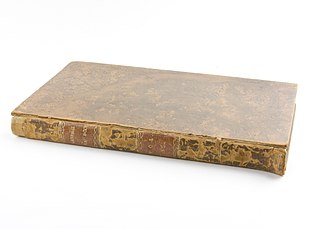
The General Stud Book is a breed registry for horses in Great Britain and Ireland. More specifically it is used to document the breeding of Thoroughbreds and related foundation bloodstock such as the Arabian horse. Today it is published every four years by Weatherbys. Volume 48 was published in 2017
The Weatherbys Group is a UK conglomerate involved in a wide range of activities largely within banking and horse racing. The original business was founded by James Weatherby in 1770.

The National Horseracing Authority of Southern Africa, known as the National Horseracing Authority for short, formerly the Jockey Club of Southern Africa is the Southern African equivalent of the American and British Jockey Clubs, whose main purposes are to prevent malpractice in horse racing and to regulate the thoroughbred horse racing industry in Southern Africa.
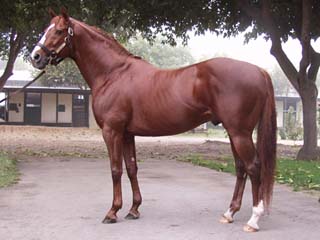
The Thoroughbred is a horse breed developed for horse racing. Although the word thoroughbred is sometimes used to refer to any breed of purebred horse, it technically refers only to the Thoroughbred breed. Thoroughbreds are considered "hot-blooded" horses that are known for agility, speed, and spirit.

The Jersey Act was introduced to prevent the registration of most American-bred Thoroughbred horses in the British General Stud Book. It had its roots in the desire of British horse breeders to halt the influx of American-bred racehorses of possibly impure bloodlines during the early 20th century. Many American-bred horses were exported to Europe to race and retire to a breeding career after a number of U.S. states banned gambling, which depressed Thoroughbred racing as well as breeding in the United States. The loss of breeding records during the American Civil War and the late beginning of the registration of American Thoroughbreds led many in the British racing establishment to doubt that the American-bred horses were purebred.

Tarrare was a British Thoroughbred racehorse. He is known for winning the 1826 Doncaster St. Leger.

Waxy was a British Thoroughbred racehorse that won the 1793 Epsom Derby and was an influential sire in the late eighteenth and early part of the nineteenth century. Waxy was bred by Sir Ferdinando Poole and was foaled at Lewes in 1790. He was sired by Pot-8-Os, a son of the foundation stallion Eclipse, whose genetic lineage traced to the Darley Arabian. Waxy's dam, Maria, was sired by the influential stallion Herod and produced one full-brother to Waxy, who was named Worthy. Waxy derived his name from a variety of potato, a choice that was inspired by his sire's name. Trained by Robert Robson, Waxy won nine races out of 15 starts during his four-year racing career, retiring from racing at the age of seven in 1797 after sustaining an injury during his last start.
Election was a Thoroughbred racehorse that won the 1807 Epsom Derby. His breeder, Lord Egremont, won the Derby for the fourth time with Election. Election raced until he was seven years old and was bought by the Prince Regent after his racing career. He was a successful sire for the Prince's Hampton Court Stud, producing the 1821 Derby winner Gustavus, the 1817 2,000 Guineas Stakes winner Manfred and 1825 1,000 Guineas Stakes winner Tontine.
Parisot was a Thoroughbred racehorse that won the 1796 Epsom Oaks. Parisot was owned by Sir Frank Standish, who won the 1796 Epsom Derby with his colt Didelot.
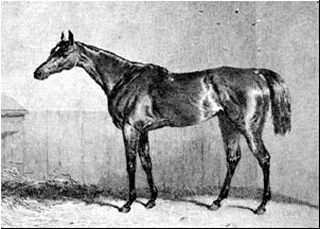
Oxygen was a British Thoroughbred racehorse and broodmare who won the classic Oaks Stakes at Epsom Downs Racecourse in 1831. In a racing career which lasted from July 1830 until April 1833 she won eight of her fifteen races and finished second on five occasions. Oxygen's Oaks was the last of twenty classic wins for her owner George FitzRoy, 4th Duke of Grafton.
Young Mouse (1826–1843) was a British Thoroughbred racehorse and broodmare who won the sixteenth running of the classic 1000 Guineas at Newmarket Racecourse in 1829. In a racing career which lasted from May 1829 until July 1830 the filly ran six times and won three races. Young Mouse won the 1000 Guineas on her first competitive appearance and then ran unplaced in the Oaks Stakes before winning two match races at Newmarket in autumn. She was retired from racing after a single, unsuccessful run as a four-year-old. Young Mouse was later exported to France where she had some success as a broodmare.

Vespa was a British Thoroughbred racehorse and broodmare who won the classic Oaks Stakes at Epsom Downs Racecourse in 1833. The filly's win at Epsom, a 50/1 upset, was the only success in her first two seasons of racing. She produced her best form as a four-year-old when she won four times, including three important races at Newmarket Racecourse. At the end of her British racing career she was sold and exported to Hungary.
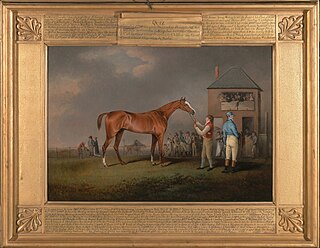
Quiz (1798–1826) was a British Thoroughbred racehorse and sire best known for winning the classic St Leger Stakes in 1801. Quiz was a durable, top-class performer, winning at least once a year in racing career which lasted seven seasons from August 1801 until April 1807. Apart from the St Leger he won many other important races including three Brocket Hall Gold Cups, two Oatlands Stakes at Newmarket Racecourse, a Great Subscription Purse at York, a King's Plate and the Jockey Club Plate. In all he won twenty-one times in thirty-six races for four different owners before being retired to stud, one of which was Mr Hallett Esq, where he proved to be a successful sire of winners.
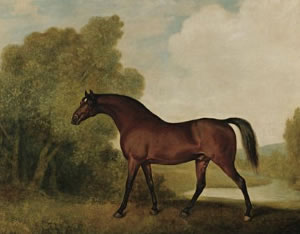
Ambrosio was a British Thoroughbred racehorse and sire best known for winning the classic St Leger Stakes in 1796. In a racing career which lasted from May 1796 until September 1799 he won fifteen of his twenty-three races. As a three-year-old he was based in Yorkshire, where he won his first three races before justifying his position as odds-on favourite for the St Leger, beating six opponents. In the next two years he competed mainly at Newmarket, where his victories three divisions of the Oatlands Stakes and the Jockey Club Plate. He returned to Yorkshire as a six-year-old to win a division of the Great Subscription Purse at York before being retired to stud. Ambrosio stood as a breeding stallion in Great Britain and Ireland, but had little success as a sire of winners.

Elis was a British Thoroughbred racehorse and sire best known for winning the classic St Leger Stakes in 1836. In a racing career which lasted from July 1835 until April 1837 he won eleven of his fifteen races. He finished second in his four defeats, two of which came when he was matched against the undefeated Bay Middleton. As a two-year-old he won five of his six races including the Chesterfield Stakes, Molecomb Stakes, Clearwell Stakes and Criterion Stakes. In 1836 he rebounded from a defeat by Bay Middleton in the 2000 Guineas to win Drawing-room Stakes, Racing Stakes, and Lewes Stakes in the summer. Elis was one of the first horses to be transported by horsebox and landed a major betting coup for his owners by winning the St Leger. He had limited impact as a sire of winners before being exported to Germany.

Mango was a British Thoroughbred racehorse and sire best known for winning the classic St Leger Stakes in 1837. He won nine of his thirteen races in a racing career which lasted from October 1836 until October 1838. Mango was well-beaten in his only race as a two-year-old and finished unplaced in The Derby but won three races at Royal Ascot in June. In September he won an exceptionally rough race for the St Leger at Doncaster Racecourse and then won the Newmarket equivalent a month later. Mango won twice in the following year, but became increasingly temperamental and difficult to manage. He was retired to stud at the end of 1838 but proved a failure as a sire.
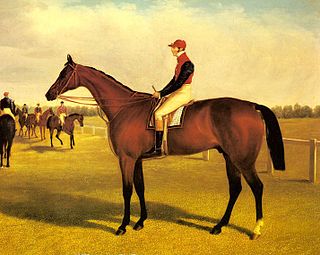
Don John (1835–1857) was a British Thoroughbred racehorse and sire best known for winning the classic St Leger Stakes in 1838. In a racing career which lasted from May 1837 until April 1839 he ran ten times and won nine races, although three of his victories were walkovers when no rival appeared to oppose him. He was one of the leading British two-year-olds of 1837, when his three wins included the Champagne Stakes at Doncaster Racecourse. In the following year he returned to Doncaster where he recorded an emphatic win in the St Leger and then defeated a strong field of older horses in the Doncaster Cup. In the following year he was campaigned at Newmarket where he was beaten for the first time by Grey Momus in the Port Stakes. After one more win he suffered serious leg injuries which ended his racing career. He was retired to stud where he became a successful breeding stallion.
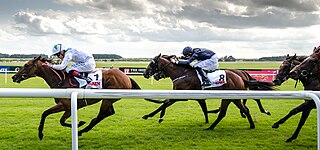
Horse racing in Ireland is intricately linked with Irish culture and society. The racing of horses has a long history on the island, being mentioned in some of the earliest texts. Domestically, racing is one of Ireland's most popular spectator sports, while on the international scene, Ireland is one of the strongest producers and trainers of Thoroughbred horses. The Irish horse racing industry is closely linked with that of Great Britain, with Irish horses regularly competing and winning on the British racing circuit.















